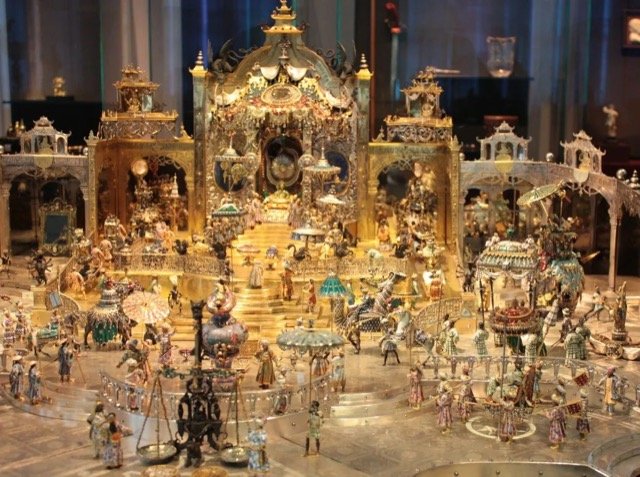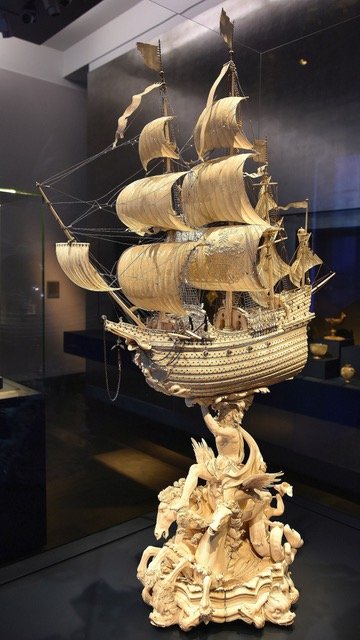Mirror of the World: Masterpieces from the Dresden Cabinet d’Art
Exhibition Miroir du Monde: Chef-D’Oeuvre du Cabinet d’Art de Dresde
Mirror of the World: Masterpieces from the Dresden Cabinet d’Art, at the Musée Luxembourg, is my kind of exhibition. Because, I think I may have mentioned this before, one of my passions is the Age of Discovery. More specifically how artists accompanying explorers on voyages of discovery depicted what they saw. An artist traveling to a terra incognita, will come upon flora and fauna that is new to him, and people, too, whose body adornments, clothes, tools, weapons and a myriad of other things, are also completely new. And then there will be colors that don’t correspond to a European artist’s palette. Which will make it difficult, sometimes impossible, to transcribe what the artist has seen.
And beyond all of that, there was the tension, the disappointment, between what explorers and artists hoped to find, expected to find and what they actually found. Like native Americans (Figure 1) rather than a sea route to the Far East. And what they didn’t find - the peoples they had been reading about in bible stories and folk tales, like the man with his head on his chest or the dog headed man or the man with a long foot to protect him from the sun. (Figure 2)
Figure 1. Engraving after drawing, native Americans become greek statues with bow and arrows
Figure 2. People Europeans expected would be found in distant lands
Since it was kings and princes and and emperors who equipped and paid for the tremendously expensive voyages of discovery, it was to them that the stuff the explores brought back, went. But what to do with all that stuff - man-made objects and strange plants, living birds and dead ones, animals, both living and dead, too, not to mention the shells and stones and gems. How to store all this stuff? How to display it? Because once a ruler had all this stuff, he wanted to make sure that his contemporaries and his subjects knew what rare and wonderful objects were in his possession. The princely collectors engaged in fierce competition, trying to outdo one another in the magnificence and rarity of the objects they amassed. The objects became demonstrations of political force and economic power. They became the objects of charged negotiations and friendly trading.
According to Wolfram Koeppe, “Throughout Europe, but especially in the principalities of Germany, the kingdoms of Scandinavia, and the Holy Roman Empire itself, collections were a reflection of princely power and magnificence. (Figure 3) Any self-respecting potentate was expected to amass an impressive display of rare corals and taxidermied two-headed calves, of misshapen pearls and mechanical toys. The one constant in these assemblages was the desire to provoke amazement in all who saw them”
Figure 3. Kunstkammer in Dresden called the Green Vault
These princely collections, cabinets of curiosities in English, cabinets d’art in French, studioli in Italian, are mostly known by their German names: kunstkammern and wanderkammern. They required, again according to Koeppe, three essential ingredients: naturalia (products of nature), arteficialia (products of man) and scientifica (instruments that confirm man’s ability to dominate nature, automatons, and scientific instruments). (Figure 4)
Figure 4. An assortment of precious man-made and natural objects for kunstkammern
And then there were the menageries, which like the kunstkammern were connected to an aristocratic or royal court and located within a garden or park of a palace. (Figure 5) Displaying exotic animals which were difficult to acquire and expensive to maintain confirmed the prince’s power and wealth. Menageries were filled with animals that were not native to Europe, like rhinoceroses and lions; monkeys and bears, camels and falcons. And exotic birds like the American turkey (Figure 6). King Manuel I of Portugal (1491-1521) had elephants from India. One of those elephants, and the rhinoceros, made famous by the famous German artist Albrecht Dürer, were gifts that Manuel gave to Pope Leo X. (Figure 7)
Figure 5. Menagerie at Chateau de Versailles
Figure 6. American Turkey, Giovanni Bologna, Bargello, Florence, after one in Francesco de Medici’s menagerie
Figure 7. Rhinoceros, Albrecht Dürer, 1515
The treasures in the Dresden collections included hundreds of pieces of gold, silver, bronze, rock-crystal and colored precious stones, shells and corals, ivory, mother-of-pearl, as well as coconuts and ostrich eggs. So many of which highly skilled European craftsmen fashioned into objects, beautiful to a European’s eye. Coconut shells, (Figure 8) for example were intricately carved and mounted with elaborate gilt-silver. Ostrich eggs were particularly prized. (Figure 9) They were rare and they were symbols of the Immaculate Conception as well as for the sol verus, the true sun, a metaphor for God.
Figure 8. Coconut Shell with putto on top and Brazilian scene carved on shell
Figure 9. Ostrich egg with with carved Ostrich & coral decoration
The very best European painters were fascinated by what the explorers brought back. Here is how the artist, Albrecht Dürer responded to the man made and natural objects he saw in 1520, when he was in Antwerp. He was there at the same time that the Holy Roman Emperor, Charles V was visiting. They both saw objects from the New World - weapons, armor, shields, implements of gold and silver, strange garments and ‘all sorts of wondrous things for many uses, much more beautiful to behold than miracles’. “In all my life, (Dürer wrote) I have seen nothing which has gladdened my heart so much as these things. For I have seen therein the wonders of art and have marveled at the subtle ingenuity of people in distant lands.”
Still life painters began to include the newly discovered flora and fauna and feathers and shells into their work. (Figure 10) Depictions of the four corners of the world began to include animals and plants native to particular parts of the world and natives native to them, too. (Figures 11, 12).
Figure 10. Flowers and Shells, Maria van Oostervick, 1685
Figure 11. Figure of America on an Armadillo
Figure 12. Allegory of Four Corners of the World
The Dresden Kunstkammer of the electors of Saxony, called the Green Vault, (Figure 13) was built directly below the royal apartments and accessible to them by a secret staircase. This room was expanded by succeeding generations until finally, between 1723 and 1730, Augustus the Strong, transformed the Green Vault into a museum in the modern sense.
Figure 13. Green Vault, Dresden
Throughout the exhibition, the museum’s curators draw our attention to the prejudices inherent in the manner in which the people and products brought back to Europe from distant lands were described and displayed. How the arts and artifacts created by non-European artists and artisans were dismissed or marginalized by terms like primitive for African, American and Oceanic cultures and exotic for the arts of Asia and India. These are issues that have not disappeared, that continue to be debated. We have all read about and seen examples of how important the arts of Africa were for Picasso. (Figure 14) We know too, that the art critic Felix Feneon, collected art from Africa and Oceana and in 1920, wrote an article entitled, “Seront-ils admis au Louvre?” (Will they be admitted into the Louvre?), in which he called for recognition of “arts from distant lands”. Like Dürer 500 years before him, he called the art of Africa and Oceana, art from remote places rather than primitive art.
Figure 14. Picasso paintings and African masks
The Musée du Quai Branly, (Figure 15) which opened in 2006 was built after French intellectuals and scientists began calling for a museum in Paris to display the arts and cultures of the indigenous people of France’s former colonies. Collections which were already in France, brought here by explorers and missionaries; scientists and ethnologists. The idea of having such a museum led to the same debate the Elgin Marbles still cause. Repatriot the objects, don’t display them in a museum in Paris.
Figure 15. Musée du Quai Branly, Paris
So, while an exhibition like this one, on the kunstkammer of Dresden may seem a quaint look into a long ago and far away world, it isn’t that at all. It’s a mirror to our world as well as that one. The visitor's attention is focused on the artistic quality and provenance of the works as well as the visions of the world that these works embody.
The exhibition at the Luxembourg begins with the instruments that made explorations possible - maps and globes document the growing knowledge of different regions of the world. (Figures 16, 17) Cleverly designed scientific instruments which the Elector himself used for his own research activities.
Figure 16. Globes, Green Vault, Dresden
Figure 17. Globe and measuring devices, etc.
As the curators write, rarity was the goal. Whether natural materials were acquired during expeditions or as diplomatic gifts, their value was a function of their rarity. The rarer something was in Europe, the greater their value. Like ivory from Africa, nautiluses from the Pacific, porcelain from China and mother-of-pearl from India. Non-European natural resources were even thought to have magical powers. (Figures 18, 19)
Figure 18, Nautilus with coral
Figure 19. Nautilus
Examples of ivory carvings from West Africa, India and the Ottoman Empire confirm that ivory was carved by artists in many parts of the world. Some objects made in India or West Africa were designed specifically for trade with Europe. Others were made by artists from the court of Saxony. (Figure 20) While natural materials like coral and mother-of-pearl inspired European goldsmiths to create amazing, virtuoso objects.
Figure 20. Ivory carving
Sketches and drawings made by artists who accompanied explorers on voyages of discovery were then engraved by skilled printmakers. The printmakers had not been on those voyages and they modified the original drawings and sketches to conform to what they and the buyers of their prints expected to see, not necessarily and sometimes not remotely, what the artist who was actually there, saw. As the curators make clear, while visual representations were motivated by scientific interest, they also paved the way for stereotyping and treating people from other cultures with disdain.
Art and artifacts from the Orient and from the Ottoman Empire were treated differently by European owners of kunstkammern. They were seen and accepted as products created by sophisticated civilizations with long histories of their own.
Porcelain became a symbol of exchange between East and West. Studies have been done that analyze global trade relations using porcelain production and sales as evidence. The Elector of Saxony amassed the largest collection of Asian porcelain in Europe. Then in 1710, he created the Meissen porcelain factory. Only 21 years later, August the Strong commissioned the Meissen artisans to create a porcelain menagerie. Many of the sculptures were based on the exotic birds and animals that he had collected on his expeditions to Africa and elsewhere. (Figures 21, 22) This menagerie was sumptuous, of course, but it was also conceived to prove the superiority of Saxon porcelain over those of its Far East rivals.
Figure 21. Meisen Peacock
Figure 22. Meisen Menagerie
From the Ottoman Empire, the court at Dresden collected tents, weapons, bridles and other equipment for warfare and pageantry. (Figure 23) Items which were copied by local artists. Indeed, at parties and parades, Augustus the Strong presented himself as a sultan, using his collection to impress and impose.
Figure 23. Ottoman room in Dresden
For us, these cabinets of curiosity, these kunstkammern and wanderkammern, are window to two distant pasts - those of faraway and long ago. And reminders too, that prejudice can distort appreciation in ways that damage everyone. (Figure 24)
Figure 24. ‘Happy’ Slave
Some more beautiful objects in the exhibition from the Green Vault, Dresden
An ornate elephant and a camel accompanied by native Americans in feather headdress and skirts


























